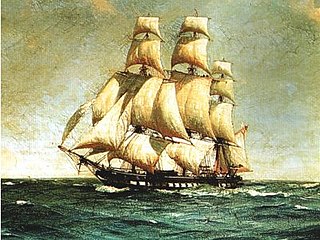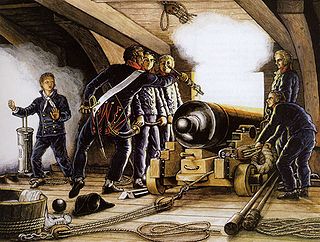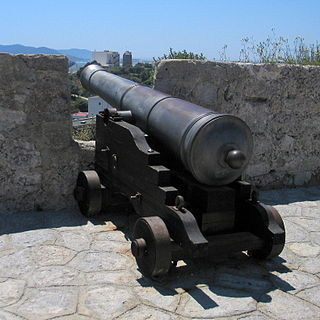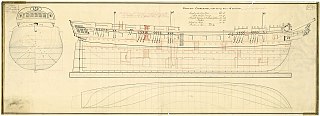
HMS Bellona was a 74-gun Bellona-class third-rate ship of the line of the Royal Navy. Designed by Sir Thomas Slade, she was a prototype for the iconic 74-gun ships of the latter part of the 18th century. "The design of the Bellona class was never repeated precisely, but Slade experimented slightly with the lines, and the Arrogant, Ramillies, Egmont, and Elizabeth classes were almost identical in size, layout, and structure, and had only slight variations in the shape of the underwater hull. The Culloden-class ship of the line was also similar, but slightly larger. Thus over forty ships were near-sisters of the Bellona." Bellona was built at Chatham, starting on 10 May 1758, launched on 19 February 1760, and commissioned three days later. She was the second ship of the Royal Navy to bear the name, and saw service in the Seven Years' War, American Revolutionary War and the Napoleonic Wars.

The rating system of the Royal Navy and its predecessors was used by the Royal Navy between the beginning of the 17th century and the middle of the 19th century to categorise sailing warships, initially classing them according to their assigned complement of men, and later according to the number of their carriage-mounted guns. The rating system of the Royal Navy formally came to an end in the late 19th century by declaration of the Admiralty. The main cause behind this declaration focused on new types of gun, the introduction of steam propulsion and the use of iron and steel armour which made rating ships by the number of guns obsolete.

Jean-Baptiste Perrée was a French Navy officer and Rear-admiral.

The second Hancock was one of the first 13 frigates of the Continental Navy. A resolution of the Continental Congress of British North America 13 December 1775 authorized her construction; she was named for the patriot and Continental congressman John Hancock. In her career she served under the American, British and French flags.

HMS Ardent was a 64-gun third-rate ship of the line of the Royal Navy. She was built by contract at Blaydes Yard in Hull according to a design by Sir Thomas Slade, and launched on 13 August 1764 as the first ship of the Ardent-class. She had a somewhat turbulent career, being captured by the French in the action of 17 August 1779, and then re-captured by Britain in 1782.

HMS Latona was a 36-gun, fifth-rate frigate of the Royal Navy that served during the American Revolutionary War, the French Revolutionary Wars, and the Napoleonic Wars. Shortly after her launch in 1781, she participated in the Battle of Dogger Bank against a Dutch squadron in the North Sea. In September 1782, Latona took part in the relief of Gibraltar and was the first ship in the convoy to pass through the Straits, when Richard Howe sent her ahead, to spy on the condition of the Franco-Spanish fleet in Algeciras Bay.

HMS Thames was a 32-gun Richmond-class fifth-rate frigate of the Royal Navy built by Henry Adams and launched at Bucklers Hard in 1758. She served in several wars, including for some four years in French service after her capture. She was recaptured in 1796 and was broken up in 1803.
Sixteen ships of the Royal Navy have borne the name HMS Alert, while another was planned:

Bellone was a 44-gun Consolante-class frigate of the French Navy.

Égyptienne was a French frigate launched at Toulon in 1799. Her first service was in Napoleon's Egyptian campaign of 1801, in which the British captured her at Alexandria. She famously carried the Rosetta Stone to Woolwich, and then the Admiralty commissioned her into the Royal Navy as the 40-gun fifth-rate frigate HMS Egyptienne. She served in a number of single-ship actions before being reduced to harbour service in 1807, and was sold for breaking in 1817.

L'Espoir was a French brig-sloop that served for 9½ years in the French Navy before HMS Thalia captured her in September 1797. In her subsequent short career in British service as HMS Espoir she captured three prizes, with the capture in 1798 of the more heavily armed Genoese pirate Liguria earning her crew a clasp to the Naval General Service Medal. Espoir was laid up in 1799 and sold in 1804.

Alceste was a Magicienne class frigate of the French Navy, launched in 1780, that the British seized at the Siege of Toulon. They transferred her to the Kingdom of Sardinia, but the French recaptured her a year later in the action of 8 June 1794. The British captured her again at the action of 18 June 1799 and took her into service as HMS Alceste. In 1801 she became a floating battery and she was sold the next year.

The 18-pounder long gun was an intermediary calibre piece of naval artillery mounted on warships of the Age of Sail. They were used as main guns on the most typical frigates of the early 19th century, on the second deck of third-rate ships of the line, and even on the third deck of late first-rate ships of the line.

The 24-pounder long gun was a heavy calibre piece of artillery mounted on warships of the Age of Sail. 24-pounders were in service in the navies of France, Spain, Great Britain, the Netherlands, Sweden, and the United States. They were comparable to the Canon de 24 Gribeauval used by the French Army as its largest piece of siege artillery. 24-pounders were used as main guns on the heaviest frigates of the early 19th century and on fourth-rate ships of the line, on the second deck of first-rate ships of the line, and on the second deck of a few large third-rates.

The 12-pounder long gun was an intermediary calibre piece of artillery mounted on warships of the Age of sail. They were used as main guns on the most typical frigates of the early 18th century, on the second deck of fourth-rate ships of the line, and on the upper decks or castles of 80-gun and 120-gun ships of the line. Naval 12-pounders were similar to 12-pound Army guns in the Gribeauval system: the canon lourd de 12 Gribeauval, used as a siege weapon, and the canon de 12 Gribeauval, which was considered a heavy field artillery piece.

Junon was a 40-gun Minerve-class frigate of the French Navy.
The action of 18 June 1799 was a naval engagement of the French Revolutionary Wars fought off Toulon in the wake of the Mediterranean campaign of 1798. A frigate squadron under Rear-admiral Perrée, returning to Toulon from Syria, met a 30-ship British fleet under Lord Keith. Three ships of the line and two frigates detached from the British squadron, and a 28-hour running battle ensued. When the British ships overhauled them, the French frigates and brigs had no choice but to surrender, given their opponents' overwhelming strength.
The French brig Observateur, which was launched in 1800 for the French Navy, was a Vigilant-class 16-gun brig, one of six built to a design by Pierre-Alexandre-Laurent Forfait. The Royal Navy captured her in 1806 and took her into service as HMS Observateur. She participated in two actions, one for the French Navy and one for the Royal Navy, and one campaign before she was laid up in 1810. The Navy did not succeed in selling her until 1814.
The Loire-class flûte was a French Navy class of two 20-gun flûtes that Louis, Antoine, and Marhurin Crucy, Basse Indre, built to a design by François-Louis Etesse, and under a contract dated 5 November 1802.

HMS Triton was a 32-gun fifth-rate frigate of the Royal Navy designed by James Gambier and launched in 1796 at Deptford. Triton was an experimental ship and the only one built to that design; she was constructed out of fir due to wartime supply shortages of more traditional materials and had some unusual features such as no tumblehome. Her namesake was the Greek god Triton, a god of the sea. She was commissioned in June 1796 under Captain John Gore, with whom she would spend the majority of her active service, to serve in the Channel in the squadron of Sir John Warren.
















